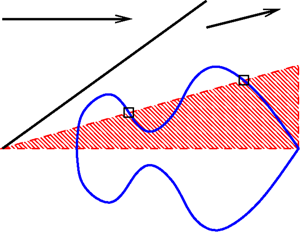Published online by Cambridge University Press: 20 April 2021

We show that shock polars for an ideal non-polytropic gas (thermally but not calorically perfect) have a unique velocity angle maximum, the critical shock, assuming a convex equation of state (positive fundamental derivative) and other standard conditions. We also show that the critical shock is always transonic. These properties are explained by a brief informal mass flux argument, which is then extended into a precise calculation. In the process we show that temperature, pressure, energy, enthalpy, normal mass flux and entropy are increasing along the forward Hugoniot curves, and hence along the polar from vanishing to normal shock; speed is decreasing along the entire polar, mass flux and, importantly, Mach number are decreasing on subsonic parts of the polar. If the equation of state is not convex, counterexamples can be given with multiple critical shocks, permitting more than two shocks that attain the same velocity angle, in particular, more than one shock of weak type, which would cause theoretical problems and practical risks of misprediction. For dissociating diatomic gases, numerical experiments suggest that positive fundamental derivative and uniqueness of critical shocks hold at all realistic pressures, although both fail at very low purely theoretical pressures.